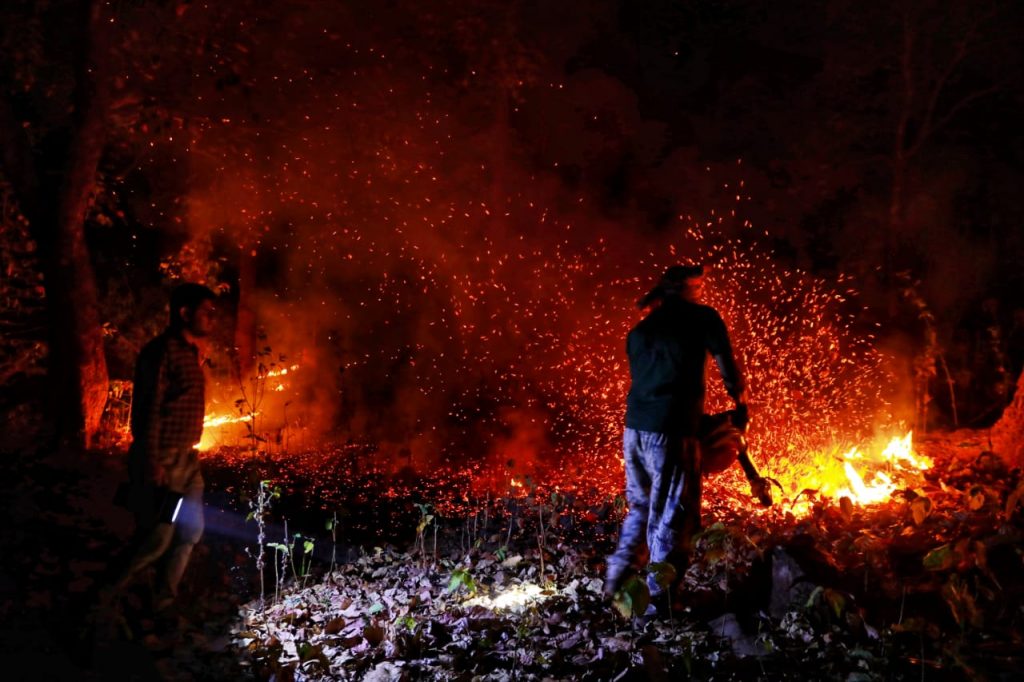The state government is reportedly caught up with a rash of forest fires in many parts of the state. The wildfires have been hogging the headlines over last week or so. Similipal was all over the newspapers. In a span of a week between February 24 and March 2, nearly 380 fire points were reported. In a phased action plan, the state government has instituted a task force to prevent recurrence of wildfires that have taken a heavy toll on the state’s fragile ecosystem. Many of the reasons behind the fires are due to human interference. From mahul flower collections to poaching as well as bushmeat hunting, there have been many reasons for such wildfires. Such fires are often triggered by people in fringe areas who depend on the forest produce for their living. They clear patches of land in the forests and to quicken the clearing process, sometimes they light fire to dry leaves lying on ground which in turn licks large swathes of forests. Many tracts of forests in Balasore, Mayurbhanj, Boudh, Sonepur, Malkangiri, Nuapada and Ganjam have been gutted. It is heartening to note that locals in Mayurbhanj Wednesday had called a bandh to protest against such fires in Similipal.
Odisha scores better than many states in the country in terms of geographical coverage of forests. Against a national average of 22 per cent, Odisha has almost 34 per cent of its geographical area under forest cover. Except for north-eastern states, a few mainland states like Kerala, Chhattisgarh and some Union Territories, we score better than any state in the country. The government has received kudos in the past for its pro-forestation initiatives. While the state’s total forest cover was 51,345 square kilometers in 2017, it increased to 51,619 square kilometers in 2019. If these forest fires continue, the record will be soon a thing of the past. The state task force will suggest measures to strengthen the mechanism for fire containment in forests. The nine-member team will be headed by former principal chief conservator of forests Sandeep Tripathy. The government has also sent an SOS to district administrations to take all what it takes to protect their respective forests. District-level committees comprising District Collectors, SPs and DFOs have been formed to ensure there are no forest fires in their respective districts. The Union Ministry for Environment and Climate Change Wednesday has formed a three-member expert team to help the state government to control the unprecedented fire incidents in the state. The team will offer expert technical advice and handholding towards early and effective dousing of forest fires. The team has been asked to stay put here till the state attains a normal situation with respect to the fire incidents.
Forest fires are not new to Odisha. Every year, seasonal fires are recorded and dealt with. However, this year the scale of fires was unprecedented. A dry spell and an early arrival of summer must have added fuel to the fire. No matter what the state government claims, there have been tremendous lose to the state’s green cover which will take years to replenish. The government should not stop at constituting a task force to fight this menace. The government must take a holistic approach to fund a solution to this recurrent menace. A wanton desire by people to maximize the returns from the nature has resulted in such disasters. Be it man-animal conflicts resulting in deaths of innocent elephants or forest fires that cause deaths of scores of wild animals, these fires have huge implications for our delicate bio-diversity. The government should encourage community participation. People in fringe villages need to be made stakeholders. Awareness building and incentivizing them periodically will help. The authorities must institute a system for ensuring 24X7 monitoring of forests and an alert mechanism in case of emergencies. For this, the forest administration must reach out to villagers on the fringes and involve them in every protection initiative. The administration also must not lose sight of climate change as a big factor. Augmentation in protection strategy, as well as a greater role for stakeholder communities, must be encouraged.
